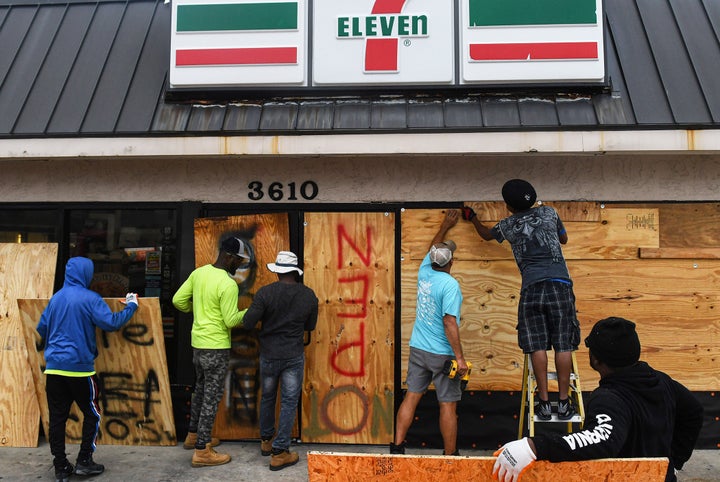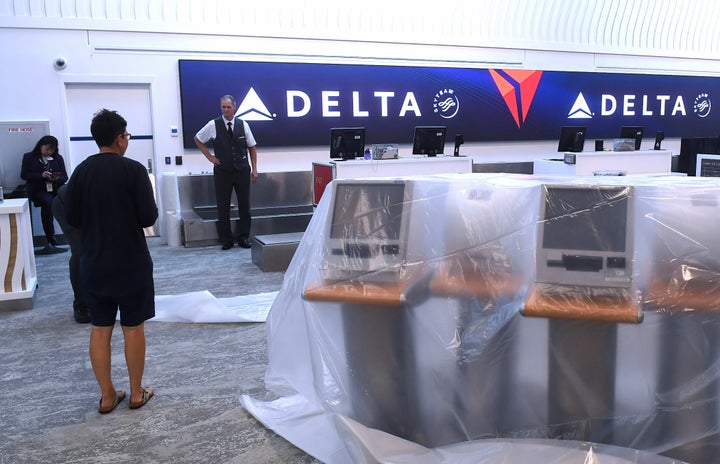The north-moving storm sent multiple homes toppling into the Atlantic Ocean after initially hitting the east coast early Thursday as a Category 1 hurricane.
VERO BEACH, Fla. (AP) — Tropical Storm Nicole sent multiple homes toppling into the Atlantic Ocean Thursday and threatened a row of high rise condominiums in places where Hurricane Ian washed away seawalls and other remaining protections only weeks ago.
“Multiple coastal homes in Wilbur-by-the-Sea have collapsed and several other properties are at imminent risk,” Volusia County Sheriff Mike Chitwood said in a social media message. In the Daytona Beach area, all bridges to the beachside have been closed to all but essential personnel and a curfew was put into effect, he said.
Wilbur-by-the-Sea is an unincorporated community on a barrier island with only beachfront homes, no condos or hotels there. Next door in Daytona Beach Shores, a strip of high-rises along what Hurricane Ian left of the beach were evacuated ahead of Nicole’s landfall because their seawalls had collapsed.
Nicole remains a sprawling tropical storm, covering nearly the entire weather-weary state of Florida while also reaching into Georgia and the Carolinas before dawn on Thursday. Tropical storm-force winds extended as far as 450 miles (720 kilometers) from the center in some directions as Nicole turned northward over central Florida.
Initial damage assessments showed how Nicole left multiple beachfront properties teetering over the water. Volusia County Sheriff’s Office posted on its Facebook page the photo of a house where erosion had undermined the ground up to its main ocean-facing wall. A roof-covered deck jutted out over the eroded slope supported on narrow timbers.
Krista Dowling Goodrich, who manages 130 rental homes in Daytona Beach Shores as director of sales and marketing at Salty Dog Vacations, witnessed the beachfront disappear behind some of the properties as evacuations were under way just ahead of the storm. She was trying to reach the scene Thursday morning to see how they fared.
“While we were there the whole backyard just started collapsing into the ocean. It went all the way up to the house,” she said. The water also compromised the remaining land between a row of tall condominium buildings nearby, she said.
In Daytona Beach Shores, where the city’s Beach Safety Ocean Rescue building collapsed onto the remaining strip of sand, officials deemed multiple multi-story coastal residential buildings unsafe, and went door-to-door telling people to grab their possessions and leave.
“These were the tall high-rises. So the people who wouldn’t leave, they were physically forcing them out because it’s not safe,” Goodrich said. “I’m concerned for the infrastructure of the area right now because once the seawalls are gone, they’re not going to just let people go back in … there will be a lot of people displaced for a while.”

Authorities had warned that Nicole’s storm surge could further erode many beaches hit by Hurricane Ian in September. The rare November hurricane prompted officials to shut down airports and theme parks and order evacuations in areas that included former President Donald Trump’s Mar-a-Lago club.
Nicole made landfall as a Category 1 hurricane at about 3 a.m. Thursday near Vero Beach, but caused no significant damage there, officials said Thursday. The brunt of the storm hit north of its center. By 10 a.m., Nicole’s maximum sustained winds were down to 50 mph (85 kph), the Miami-based center said. The storm was centered between Tampa and Orlando, moving west-northwest near 16 mph (26 kph).
The storm left south Florida sunny and calm as it moved north, but could dump as much as 6 inches (15 centimeters) of rain over Blue Ridge Mountains by Friday, the hurricane center said. Flash and urban flooding will be possible, along with renewed river rises on the St. Johns River, across the Florida Peninsula. Heavy rainfall will spread northward into the eastern Ohio Valley, Mid-Atlantic, and New England through Saturday.
Nicole became a hurricane Wednesday evening as it slammed into Grand Bahama Island. It was the first to hit the Bahamas since Hurricane Dorian, a Category 5 storm that devastated the archipelago in 2019. For storm-weary Floridians, it is only the third November hurricane to hit their shores since recordkeeping began in 1853.
Forty-five of Florida’s 67 counties were under a state of emergency declaration. President Joe Biden also approved an emergency declaration for the Seminole Tribe of Florida, ordering federal help for the tribal nation, many of whose members live on six reservations around the state. The tribe also owns the Hard Rock Cafe franchise, with several of its hotels and casinos in Nicole’s path.
Gov. Ron DeSantis said at a Thursday news conference in Tallahassee that about 333,000 electric customers were without power at mid-morning, about 2.9% of the state’s total. DeSantis said there were 17,000 electric linemen ready to begin restoring power and that numerous other assets including rescue boats and vehicles will be deployed as needed.

“We’re ready and we have resources to respond to whatever post-storm needs may arise,” the governor said.
Disney World and Universal Orlando Resort announced they likely would not open as scheduled Thursday. Almost two dozen school districts were closing schools and 15 shelters had opened along Florida’s east coast, the governor said.
Parts of Florida were devastated by Hurricane Ian, which struck as a Category 4 storm. Ian destroyed homes and damaged crops, including orange groves, across the state — damage that many are still dealing with — and sent a storm surge of up to 13 feet (4 meters) onshore, causing widespread destruction.
Credit: Source link